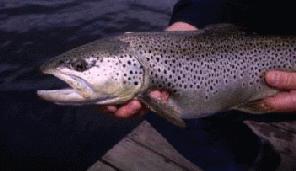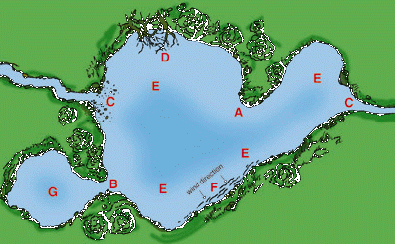
No Traffic Trout
by Dave Carty
Considering the current fascination with fly fishing, it's no wonder that uncrowded trout streams near paved roads are becoming a thing of the past. But that's not all bad. People flocking to accessible lakes and rivers just means that hard-to-reach waters are ignored.

Many of these places are just a short jaunt off the road, too. A couple of years ago, I packed a float tube several hundred yards into a lake that, although well known by locals, was virtually deserted that day. I paddled around for most of a cold, wet morning — abuse I wouldn't have put up with if I hadn't been catching 14- to 16-inch cutthroats.
What To Look For
I've spent more than half my life fishing in or near the Rockies, but walk-in fishing exists nearly everywhere in the country. With a little determination and research, you can find uncrowded hotspots almost anywhere.
Although finding great fishing at the end of a 10-mile trail is certainly possible, don't ignore places that are close to roads. If they can't be seen from the highway, they may not be heavily fished. Even streams that are literally surrounded by people have sections that are relatively untouched.
When I lived in Colorado, a trout stream ran directly through the middle of the city I was living in (with a population approaching 100,000). Locals hit the "flies and lures only" section of that stream quite hard, leaving other stretches virtually unfished.
A friend and I usually fished below the no-kill section and often had the place to ourselves. My buddy's biggest fish from that little creek was 17 inches long, a rainbow far bigger than anything I had taken in the more popular water above.
Another friend of mine, a man who has a lot of time on his hands, finds new water the old fashioned way: by looking for it. He scans Forest Service maps for an area he hasn't worked in a while, pinpoints a lake or two, and sets out to see if they contain fish. Some do and some don't, but he has quite a collection of backcountry lakes at this point, nearly all within a half-day's hike from the road.
State fisheries agencies are a valuable source of information for the status of an individual lake's trout populations, which lakes are regularly stocked, and which ones receive little fishing pressure.
Approaching Backcountry Waters
Once you settle on a lake, find an overlook of some sort and take a minute or two to scan the shoreline. Lacking current to bring food to them, trout living in lakes routinely cruise the banks, often not more than 10 or 20 feet from the shoreline.
Since the cool water in mountain lakes rarely stratifies, the fish may occupy fairly shallow areas throughout the open-water season.

In fact, the fish are sometimes surprisingly close to shore, which always amazes those who spend hours vainly casting to trout that seem to be rising in the precise center of the lake. As you survey the water, look for potential shoreline feeding areas with easy access to deeper water.
Cover, in the form of downed trees and sunken logs, is also a plus and should be explored. Points and narrow areas that concentrate forage or trout movements are also worth a shot. So are shallow bays that may produce more insect hatches than the cooler main lake basin.
If the fish aren't cruising shoreline cover, I try to locate a drop-off that can be worked with spoons. Trout often hold on the very edge of sharp drop-offs. Flinging a spoon over the edge of one of these breaklines and bringing it back to the shallows can pay off — big.
In the middle of the day, when the fish are lying low, a good way to dredge up sulking trout is to cast a spoon into the middle of the lake, count slowly as it sinks, and then retrieve it. If a count of five doesn't work, try six, then seven, and so on. Sooner or later, one of your counts will connect with a fish, indicating the depth at which the trout are holding at that moment.
Current areas, particularly inlets, are also worth fishing, especially late in the day. As the sun begins to set, trout move into inlets to feed, sometimes swimming up a fair distance. Spawning trout often seek current and clean gravel bottoms; look for rainbows and cutthroats here during the spring.
On occasion, even outlets can be good. There is a lake I know — no, I'm not going to divulge its location — that sports decent fishing, but much more exciting action awaits a mile or so down the tiny outlet brook.
Even at my hot-spot the brook is still not more than three feet wide, but it has carved deep runs through the soft meadow mud and harbors a good population of extremely spooky trout.
Although a tiny spinner works quite well, I enjoy tossing flies under its overhung banks and down its tiny riffles.
Another hotspot — if you don't mind casting into the wind — is a wind-swept shoreline. Trout often hold very close to shore, feeding on minnows, insects and other morsels tossed around by wind and waves. The lake's choppy surface seems to give the fish a sense of security that glass-calm waters cannot offer.
Tread Lightly
When I was in high school, a friend made a family pilgrimage to the same backcountry lake every fall, and upon his return he'd display photos of the dozens of huge trout they had caught. Within a few years the fish disappeared. Although my buddy's family was probably the only group to fish that place, the trout they hauled out put a big dent in the lake's fragile population.
The moral of the story is that many backcountry lakes don't always hold a lot of trout, so keep a few for dinner, if you like, and let the rest go. They'll be waiting for you and your friends the next time you visit.
